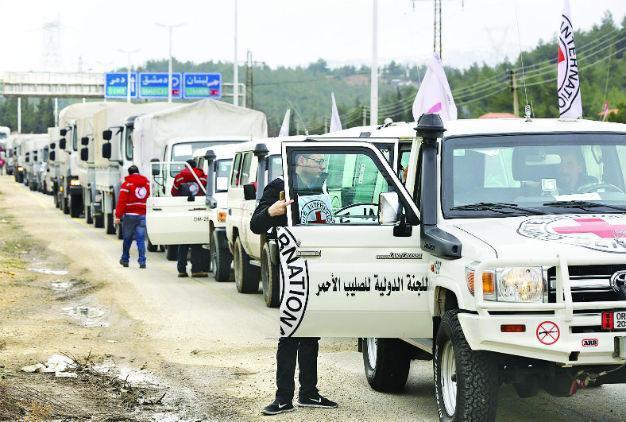Aid trucks reach three besieged Syrian towns
UNITED NATIONS - Agence France-Presse

AFP photo
Aid trucks have reached three besieged towns in Syria, while negotiations to evacuate some 400 Syrians on the brink of death are being conducted.Aid workers found the 400 Syrians suffering from starvation, malnourishmnt and other illnesses during a visit to a hospital in Madaya, said U.N. Aid Chief Stephen O’Brien.
“Around 400 are in need of being evacuated for life-saving medical attention,” O’Brien told reporters following a closed-door UN Security Council meeting. “They are in grave peril of losing their lives.”
The United Nations has asked the Syrian government and armed groups controlling access the town to allow the 400 Syrians to be transported out of Madaya, he said.
Hours earlier, a convoy of 44 trucks loaded with food, baby formula, blankets and other supplies entered Madaya, which has been under siege by President Bashar al-Assad’s forces for six months.
An additional 21 trucks delivered supplies to two other towns besieged by the rebels; Fuaa and Kafraya.
The UN Security Council met to discuss the situation in Madaya where residents told AFP they had resorted to eating grass and killing cats for meat to survive.
Humanitarian groups were negotiating with all sides for the evacuation of 400 people from the besieged Syrian town of Madaya, the Red Cross said on Jan. 12.
The United Nations, the International Committee of the Red Cross (ICRC), and the Syrian Arab Red Crescent are now working to evacuate around 400 people in need of urgent care, said ICRC spokesman Pawel Krzysiek.
“It’s a very complicated process that needs permission to realise this humanitarian operation. We are in negotiations with all parties,” Krzysiek told AFP.
The suffering in Madaya is the worst seen in the country’s civil war, the United Nations said on Jan. 12.
“There is no comparison in what we saw in Madaya,” the U.N. refugee agency’s chief in Damascus, Sajjad Malik, told journalists in Geneva, when asked to compare the devastation in the town to other areas in Syria.
He said there were “credible reports” of people starving to death during the months-long siege by pro-regime forces.
“There was no life,” said Malik, who was in the convoy, describing a town of desperate people who in many cases were too weak to voice outrage over their suffering.
The World Health Organization (WHO) has asked the Syrian government for permission to send mobile clinics and medical teams to Madaya to assess the extent of malnutrition and evacuate the worst cases, its representative said on Jan. 12.
Elizabeth Hoff, WHO representative in Damascus who went into Madaya on Jan. 11 in the convoy, said the agency needed to do a “door-to-door assessment” in the town of 42,000 people, where a Syrian doctor told her 300-400 needed “special medical care.”
“I am really alarmed,” Hoff told Reuters, speaking by telephone from the Syrian capital where the Norwegian expert has been based since July 2012.
“People gathered in the market place. You could see many were malnourished, starving. They were skinny, tired, severely distressed. There was no smile on anybody’s face. It is not what you see when you arrive with a convoy. The children I talked to said they had no strength to play.”
















